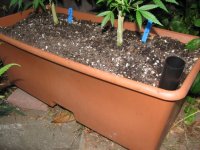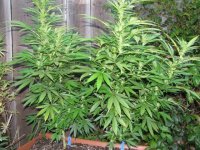Hey Gantz! I wondered when you'd show up! Cascadia seems to be intent on making the Earthbox Guerrilla friendly, and I am developing a spin-off device I call the GSWD, its kind of a attempt to bring the advantages of the Earthbox to in the ground planting.
What do you think of the air-tight refill system I came up with? I figure its just the thing to extend time between visits for the Earthbox and the GSWD, I'll have a build with pictures up on the GSWD and the airtight rez sometime in the next couple days.
What do you think of the air-tight refill system I came up with? I figure its just the thing to extend time between visits for the Earthbox and the GSWD, I'll have a build with pictures up on the GSWD and the airtight rez sometime in the next couple days.






